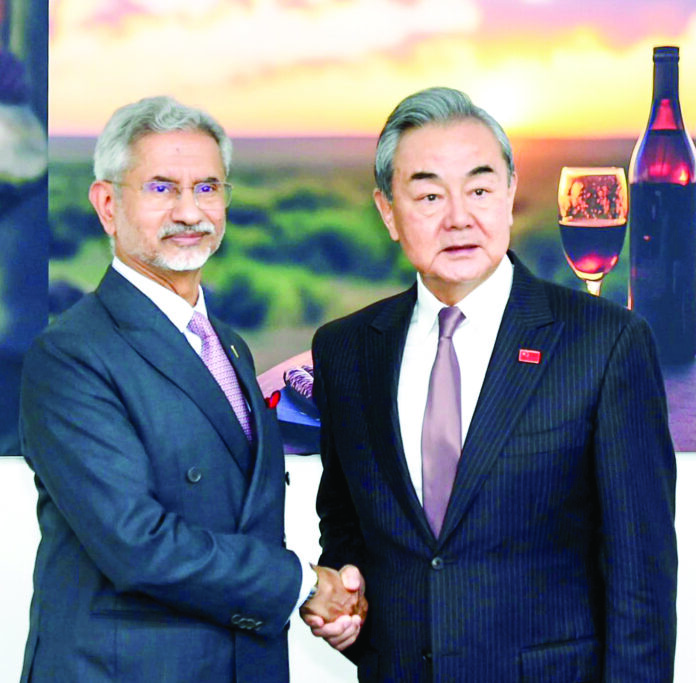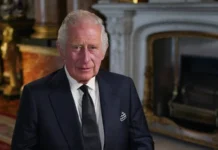
While leadership level meetings offer hopes of progress and new beginnings, the relationship remains mired with its own set of challenges.
On 21 February External Affairs Minister Dr S Jaishankar met Chinese Minister of Foreign Affairs Wang Yi on the sidelines of the G20 Foreign Ministers’ Meeting in Johannesburg. The meeting was in line with a series of high-level exchanges taking place between the two sides since the announcement of the border accord in October last year.
JAISHANKAR-WANG YI MEETING
External Affairs Minister Jaishankar’s meeting with Wang Yi took place almost a month after Foreign Secretary Vikram Misri visited Beijing to meet Chinese Vice Foreign Minister Sun Weidong (26-27 January). Misri’s visit followed successive meetings between Indian National Security Advisor Ajit Doval and China’s Minister of Foreign Affairs Wang Yi for the 23rd Meeting of the Special Representatives of India and China (18 December), and Prime Minister Narendra Modi’s meeting with Chinese President Xi on the sidelines of the 16th BRICS Summit in Kazan, Russia (23 October 2024).
Notably neither India nor China issued press statements on the Jaishankar-Wang Yi meeting. Yet Indian Ministry of External Affairs Spokesperson Randhir Jaiswal at a weekly media briefing elaborated that the two ministers discussed “management of peace and tranquillity in border areas, Kailash-Mansarovar-Yatra resumption, trans-border rivers, flight connectivity and travel facilitation” and exchanged “views on G20 and SCO.”
The optics seemed promising. The photo op just ahead of the meeting saw a smiling Jaishankar briskly shaking hands with Wang Yi. Later in his opening remarks at the meeting, Jaishankar highlighted that India and China had made ‘notable developments’ since the last G20 Summit in Rio in November 2024, especially in terms of management of border areas. While the meeting was high on optics, it did not yield fresh outcomes or spell out definite progress on the outcomes previously agreed between Foreign Secretary Misri and Wang Yi in January.
THAW OR NOT?
The successive high-level exchanges between India and China over the past few months have been hailed by many in New Delhi’s foreign policy community as a sign of diplomatic thaw. However, it is important to note that the supposed “normalcy” in ties have struck the chord at a time when two important developments are simultaneously taking place at a regional and international level: geopolitical uncertainty in South Asia and Donald Trump’s return to office as the US President for a second term.
US President Donald Trump’s second term in office has brought with it a message for China. Trump’s policy and strategic moves since assumption of office such as offering External Affairs Minister Jaishankar a front row seat at his inauguration ceremony, appointment of China hawks namely Marco Rubio, National Security Advisor Michael Waltz in his cabinet, imposition of 10 percent tariff on all Chinese imports, criticism of China, Brazil and India as ‘tremendous tariff makers’ have sent definite signals to China. Trump’s negative messaging to China and his previous track record of unpredictable administrative policies has in all likelihood pushed Beijing to recalculate its position along the Line of Actual Control (LAC). This apart other factors like China’s pre-occupation with overlapping territorial claims in the South China Sea, cross-strait tensions with Taiwan at a time when its economy is demonstrating slowing growth, New Delhi’s turn to host the Quad Leaders’ Summit in 2025 – that will see the participation of a host of new faces like Trump, Japanese Prime Minister Shigeru Ishiba, Australian federal elections pending – a platform where discussions on China are likely to be very high on the agenda are possibly some factors that have resulted in Chinese re-posturing at the border for the time being. Trump’s return to office in the US has therefore played a major role in driving Beijing to engage with New Delhi diplomatically and militarily resulting in the successive high-level meetings.
While leadership level meetings offer hopes of progress and new beginnings, the relationship remains mired with its own set of challenges. Despite External Affairs Minister Jaishankar’s confirmation in December last year that disengagement had been fully achieved in Eastern Ladakh, there continues to be heavy militarisation along the border.
In January, Army Chief Upendra Dwivedi during a media interaction had described the situation at the LAC as ‘stable but sensitive’ and emphasised that a ‘degree of standoff’ still existed along the border. On 20 February Dwivedi in a podcast highlighted that the terrain along the border had been ‘doctored’ and confirmed that both India and China in their respective sides of the border had ‘constructed billeting…roads over a period of time’ altering capabilities of forward movement of troops. Additionally Chinese moves such as building Xiaokang dual-use border defence villages, assertive military and infrastructure buildup along the LAC including construction of airfields, tunnels, fuel and ammunition storage buildings, and its latest decision to establish two new counties (He’an County and Hekang County) in the Hotan Prefecture that will incorporate Ladakh’s territory hint at flagrant contradiction between the rhetoric of de-escalation and Beijing’s real-time dedication to combat readiness and geopolitical contestation.
Other traditional challenges include Beijing, a P5 member, not endorsing New Delhi’s position of seeking a permanent seat at the United Nations Security Council (UNSC), opposing India’s membership bid to the Nuclear Suppliers Group, and blocking Indian initiative to place Pakistan-based terrorists in the UNSC’s 1267 committee sanctions list. Further, with complete resolution of the border standoff in Eastern Ladakh still impending, China’s construction of a proposed hydropower dam in the lower reaches of the Yarlung Tsangpo river has weaved in another layer of complexity in the bilateral ties.
The complex trajectory of bilateral ties between India and China, an unfolding global unpredictability due to the Trump presidency and the latest surge in China’s aggressive posture in the South China Sea ascertain that China has opened up multiple fronts of conflict at once and the present ‘peace’ between India and China – demonstrated through episodes such as the Jaishankar-Wang Yi meeting – is only a tactical thaw by Beijing. India should not let its guard down. Till China’s words meets deeds the de-escalation of tensions must not be confused as a reset of ties.
* Dr Shaheli Das is a Visiting Fellow at Fudan Development Institute in Shanghai.






